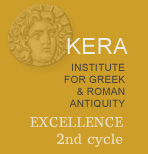Main Site . Other insciptions from the main site of Boubon
32. Honorary decree of the city of Oinoanda
![]()
5 |
[Τερ]μησσέων τῶν πρός [Οἰν]οάνδοις ἡ βουλή καὶ ὁ [δῆμ]ος καὶ ἡ γερουσία ἐτει– [μησ]εν εἰκόνι χαλκῇ ἐν ἀν̣– [δριά]ντος ἀναστάσει vac...... |
The council, the people and the senate of the Termessians at Oinoanda honored with a bronze portrait in the form of a statue to be erected (for him) [(name of the honorand)......... ]
Block forming the upper part of a profiled statue base, first seen and documented in August 2004. The stone was partly buried in the soil in the lower area of the southern slope, where several rectangular bases with honorific inscriptions had been found, some of which contained decrees for deceased citizens (see nos. 23, 25 and 26). In addition to the inscribed surface, the right and bottom faces of the stone are preserved and were visible in 2004. In subsequent years, we found the block almost entirely buried.
Height: 46 cm; length: not available; depth: at least 62 cm (profile); at least 53 cm (shaft); letters: 3-3.5 cm.
Unpublished
Ll. 1-2 : 'The Termessians at Oinoanda' was "the full juridical title of the citizen body of Oinoanda, recalling their foundation by colonists from Termessos in Pisidia, probably about 200 BCE" (Milner and Eilers 2006, p. 66). Contrary to previous assumptions, Termessos Minor (Mικρά) referred to the city of Oinoanda itself, as opposed to a different municipality, or even a distinct community within the polis of Oinoanda; see Coulton 1982; cf. Wörrle 1988, pp. 47-49; Eilers and Milner 1995, p. 85; Le Roy 1996, pp. 964-966.
Ll. 4-5 : Though the meaning of the phrase ἐν ἀνδριάντος ἀναστάσει seems evident in this context, I know of no other parallels in honorary decrees for this expression. The honor to be bestowed by the city of Oinoanda (to a citizen of Boubon most likely) is referred to as a portrait in bronze and then specified as a statue, as opposed to a bust, presumably.

